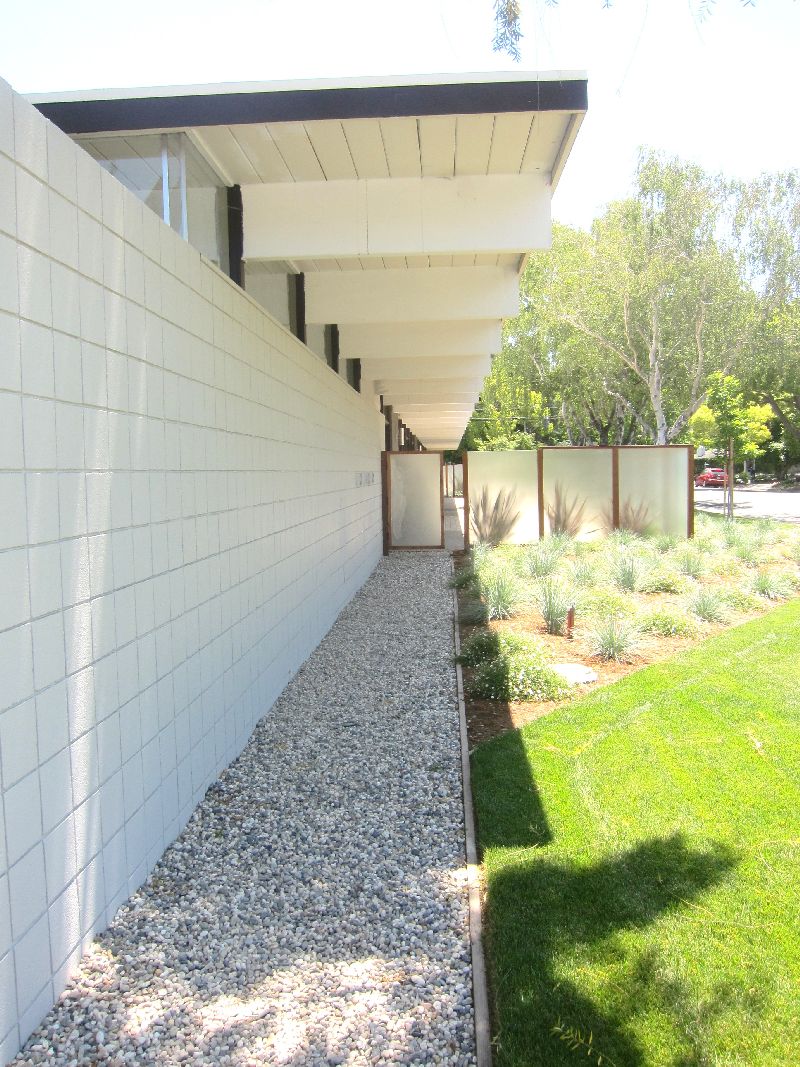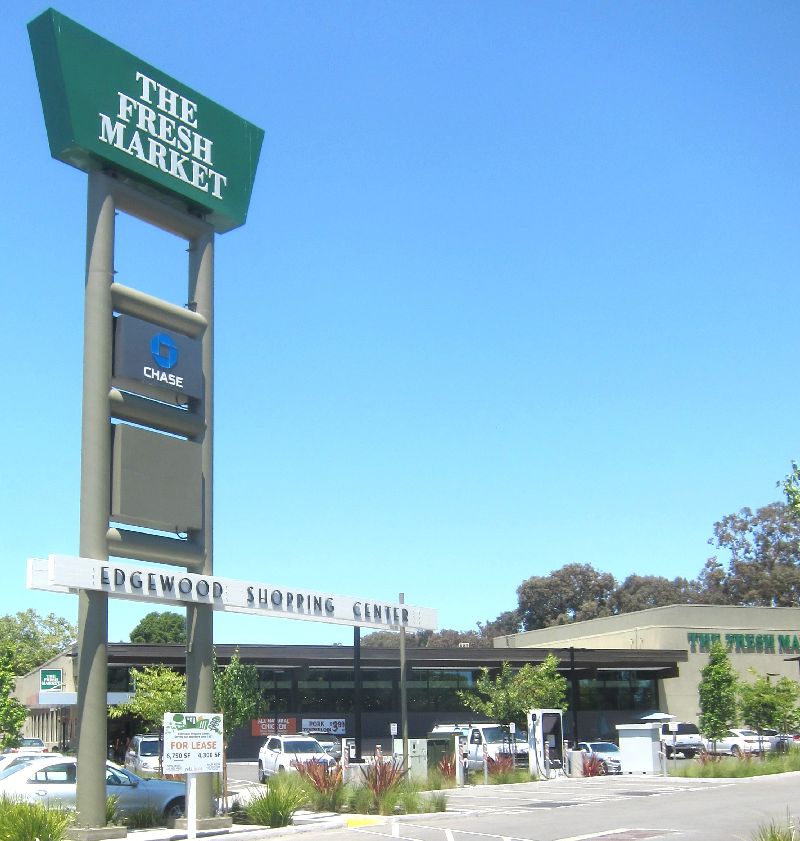
Edgewood Center is an Eichler No More
 |
|
|
As standard shopping centers go, the rebuilt Edgewood Shopping Center looks OK—lots of glass, attractive landscaping, a retro freestanding sign. But it is no longer an Eichler.
The developer “took a genuine, excellent, and historic example of mid-century modern architecture by widely recognized and talented architects, Jones and Emmons, and turned it into a bad copy of mid-century modern. A real loss,” says Alan Hess, an architectural writer, architectural critic with the San Jose Mercury News, and a proponent for preserving the shopping center.
“The remodel is heavy handed and badly proportioned, where the original was deft, graceful, and blended beautifully with the neighborhood.”
 |
|
|
Still, the revived shopping center, at Embarcadero Road alongside Highway 101, appears to be commercially successful. Fresh Market is doing good business, selling a full range of groceries. Faux 'Local 100' road signs are posted throughout, pointing to where its produce is grown. "Del Cabo Farms, Watsonville, 41 miles," reads one. Chase has a banking outlet too.
Sami Zeger, leasing agent for the retail sites, says all retail spaces are under contract negotiations, and several have already been leased. Soon to open, she says, will be Starbucks, Supercuts, a dry cleaner. Discussions are underway with a tutoring center, a fitness studio, a casual eatery.
Nobody has complained to her about the architectural changes. "I know they really tried to keep the integrity of the architecture and the historic nature," Zeger says.
"I think people are really fond of the new buildings," she says. "It’s going to be a really good addition to the neighborhood and definitely an asset to the people living and working in the area."
For more than a decade a battle raged between developers hoping to tear down the Palo Alto shopping center, built by Joe Eichler in 1956 to designs by A. Quincy Jones.
Proponents argued that the shopping center, which had grown increasingly derelict, could be restored while preserving its historic architectural look, and that it was an important and rare example of a planned community incorporating housing, stores, and offices.
For many years Joe Eichler himself had his office here, in a building whose exterior has been refurbished but whose interior has been largely gutted. Edgewood was the only shopping center Eichler ever built.
 |
|
|
Neighbors, who banded together as the Edgewood Plaza Preservation Alliance, fought the development in court—and, seemingly, prevailed. They argued that the neighborhood’s covenants restricted how much could be developed on the site.
Neighbors were joined in their fight by a number of architectural historians, including Hess.
Developer John Tze of Sand Hill Property originally wanted to tear down all or most of the center. “What I'm proposing is some startling change,” he said in a public meeting in 2007. “It's not going to be mid-century modernism.”
But because of the neighbors’ lawsuit, in 2009 a settlement was reached. Tze agreed to preserve the buildings and move them around on the site, while adding houses to part of the site. The two retail buildings were to be restored according to the strict historical guidelines of the Secretary of the Interior.
In March 2012, the Palo Alto City Council approved the development plan for renovating the two retail buildings and the office, building 10 houses and adding a small park. Some neighbors had been mollified, others remained miffed.
Six months later many were horrified when crews demolished one of the two retail buildings the developer had promised to restore. The building was to have been taken apart, moved on site, and rebuilt.
“We were not notified about the demolition and were surprised, shocked and dismayed,” Diane Sekimura, one of the leaders of the pro-Edgewood fight, told the Palo Alto Weekly.
 |
|
|
The Palo Alto Weekly quoted from an email of apology Tze sent to Sekimura:
“I do not take this lightly—but basically, what we found through the design process was that much of the old material could not be re-used. The glass does not meet current safety and energy codes—it is single pane, non-safety, and we need double-paned with light-and-heat reflecting glass. The doors likewise do not meet handicap widths. However, the signature Eichler concrete block walls will be re-used and incorporated into the building that is staying in place.”
The City of Palo Alto assessed a penalty of $94,200 against Sand Hill for demolishing the structure “without notifying or receiving approval from the City.”
The destroyed building was reconstructed with new materials.
No one from Sand Hill Properties returned calls from the Eichler Network for this post.
Hess notes that the passageways between the stores, which were tied together using open beams, “have been destroyed.”
“The shame of it is that, except for the housing, the original buildings could have been restored in place,” Hess says, “and been successfully leased to the same upscale stores that are now moving into the remodeled version. Edgewood Plaza was an important landmark in suburban postwar development, showing how suburbia was not (as is widely believed) all badly planned sprawl, but had good examples of integrating housing, shopping centers, and offices into a pedestrian-oriented neighborhood with high architectural values.”
- ‹ previous
- 160 of 677
- next ›



